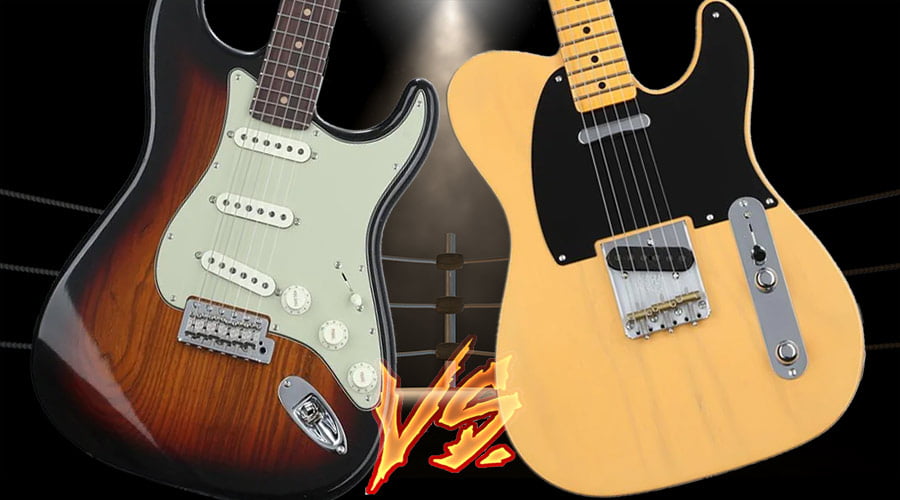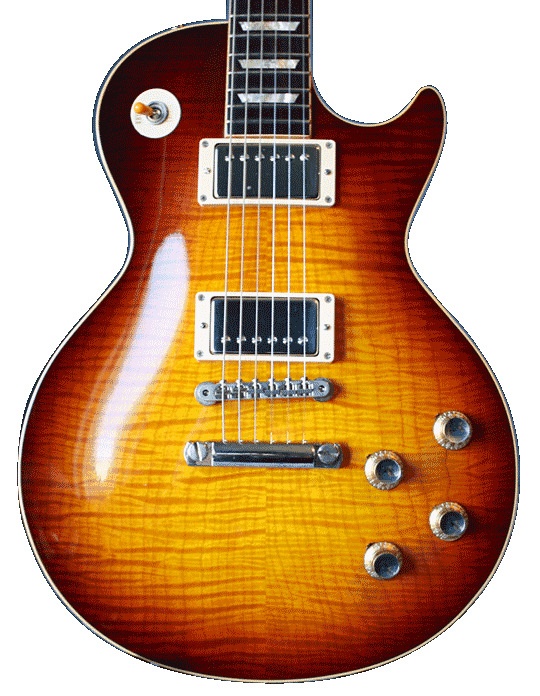
If you are in the market for a new Fender guitar, that’s awesome! It is a great time to be guitar shopping, whether online in the dozens of internet retailers or out at the musical instrument department stores, you are sure to find an awful lot of guitars to choose from.
One of those choices will be between the Stratocaster and the Telecaster. But what, you wonder, is the difference between these two? We’ll go over the major and some minor points of these two classics and try to sort out their differences and similarities.
| Stratocaster | Telecaster | |
| First Released | 1954 | 1951 |
| Body Wood | Alder | Ash |
| Pickups | 3 single coil | 2 single coil |
| Scale Length | 25.5″ | 25.5″ |
| Vibrato Bridge | Yes | No |
Headstock
At first glance, the headstocks of the Stratocaster and Telecaster appear to be very different with the larger profile of the Strat ‘stock and the smaller, softer curves of the Tele ‘stock. In fulfilling the purpose and function of a guitar headstock they are identical.
The very same tuning machines and string trees may or may not be found on both guitars as they share parts easily. The nuts on both are the same. Both will have their respective Fender identification right on the front, and most versions of both will have their serial numbers around the back. Most models of Strats and Teles will have the truss rod access up in the headstock as well, so all in all, this part is the same for Tele and Strat.
Neck
You will immediately notice the two very different-looking fingerboards on the necks of both Stratocasters and Telecasters. The lighter maple and the darker rosewood are used in equal proportion on both guitars. Along with the variety of frets used on both, the fingerboard material is functionally the same on both guitars, and they share a scale length of 25.5”.
The radius of the fingerboard, that is the slight curve across the front of it, is shared by both Strat and Tele. 7.25”, 9.5”, and 12” radii are the most common for both guitars. The profiles of the two necks can vary somewhat, with the Telecaster shape generally being rounder, and the Stratocaster somewhat slimmer from front to back than the Telecaster.
Body
The differences in the body shapes and contours between the two are quite apparent. The single-cutaway Telecaster has somewhat sharper edges all around, while the double-cutaway Stratocaster has rounded, smoother edges to the body, and is slightly longer. The double-cutaways of the Stratocaster also allow for somewhat easier access to the higher frets, but it is fair to say that anyone that wants to get up there will, no matter which they are using!
The back of the Strat sports the “tummy cut”, a contour at the top edge, while the Tele is a flat slab for the most part. The Stratocaster has the tremolo spring assembly routing and cover while the Telecaster has six simple string ferrules that hold the end of the string as it passes up through the bridge. Both have identical neck plates. And both guitars will, for the most part, share paint colors, depending on the models.
Screwed to the bodies will be two very different pickguards. The small Telecaster pickguard holds nothing but the neck pickup, so the pickup selector and volume and tone pots are held by the long control plate on the bottom edge. The Strat pickguard is considerably larger and has to be because it holds everything else, the single functional difference between the two pickguards.
Pickups, Pots, Switch, and Jack
Another obvious difference will be the pickups. Both sets are functionally similar single coil pickups while looking different, and the Strat adds the middle pickup, which adds some tonal options. Along with the extra pickup, the Stratocaster has a 5-way switch in order to use all three pickups, along with combinations of neck/middle and middle/bridge, while the Tele has a 3-way switch for use of the neck or bridge pickups, and both.
The Stratocaster has three control potentiometers (pots), a master volume for all three pickups, and two tone pots that control the bass/treble response of the neck and middle pickups. With one less pickup, the Telecaster has a single master volume and a single master tone pot.
All of this sound sorcery has to leave the guitar and get to the amplifier and does so via the jack. The round Telecaster jack is mounted on the bottom edge, while the Strat wears the surface-mounted jack right on the front. Both are identical in function, and neither has changed in about 70 years.
Bridge
The last considerable difference between these two great guitars is the bridge, the metal plate that holds the strings at the body. Both bridges have saddles, the Stratocaster with 6 saddles, and most Teles have 3. The saddles are used to intonate the guitar, that is, ensure that it is in tune all over the neck.
Besides being somewhat smaller, the Stratocaster has a tremolo bridge, even though the word tremolo is incorrect, we’ll call it what Leo Fender called it. After the tremolo arm is screwed into the bridge it is used to vary the pitch of the string both down and up, or only down, depending on how the bridge is set up. The larger plate on the Telecaster does not have this feature, and most would say it shouldn’t!
Putting Both to Good Use
While they sound remarkably similar, the Stratocaster and Telecaster can sound distinctly different. The Strat can be more mellow, with a rounder sound, while the Tele is brighter and sharper. Both provide gorgeous clean tones, and both are quite adept at harder, overdriven Rock sounds.
Both guitars are very well balanced, both hang really well, and despite their differences in curves and contours, both the Tele and Strat move well with the player. And both guitars, on average, weigh about the same.
The Stratocaster and Telecaster are both suitable for virtually any musical style and are proven time and time again by players in all genres. Telecasters are only good for country and Stratocasters are not good for heavy rock are two good myths to ignore. These two classics have been around for as long as most modern types of music have, and they have both been a part of them all.
Final Thoughts
With the differences and similarities somewhat cleared up, the choice still isn’t an easy one. For the most part, the two guitars are quite similarly priced, and when one is on sale the other usually is too. The best way to know the difference is to give a few of each some good play time and see for yourself. After the most difficult choice, the color, of course, the Stratocaster or Telecaster that speaks to you and more importantly, answers you is the right one. Good luck choosing and above all, have fun!
Share your thoughts in our forum! 💬
👉 Introduce yourself and show off your guitar and other gear.
Frequently Asked Questions
Which is better for beginners: Stratocaster or Telecaster?
With a slimmer neck, the Stratocaster is generally thought of as a bit easier to play, causing less fatigue and more quality time playing for the new guitar player. The double-cutaway design allows easier access to the higher frets and this is also a plus for the beginner.
What makes a Stratocaster sound different from a Telecaster?
With somewhat different pickups, the two guitars will naturally sound different when played through the same amplifier. The third pickup and two extra switch settings will also give the Stratocaster a range of sounds not available on the Telecaster. And the Strat tremolo bridge and springs contribute to the overall difference in sound between the two.
Is a Telecaster less guitar than a Stratocaster?
Two words: Absolutely Not At All. Sure, it has one less pickup, it’s a slab of wood without all the curves and contours, and it doesn’t have the fancy bridge, but the Telecaster is every bit the Rock and Roll machine that the Stratocaster is. As performance equals, the two guitars deserve a place in every guitar player’s lineup.
Share this post with your friends using these one-click sharing options:
👉 Click here to share on Facebook.
👉 Click here to share on Twitter.
👉 Click here to share on LinkedIn.

Get the latest reviews, guides and videos in your inbox.